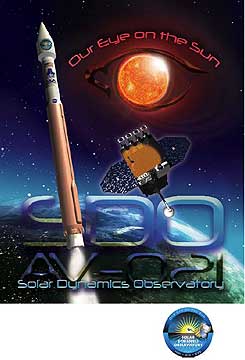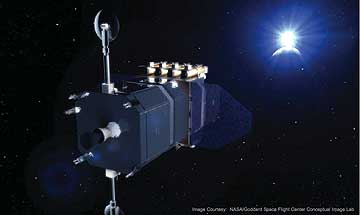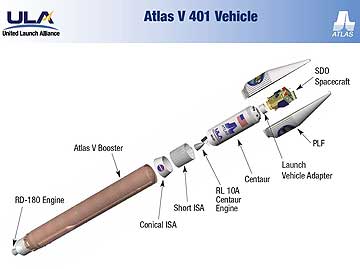
NASA TV will broadcast the launch live beginning at 8 a.m. EST. A simulcast of the launch can be viewed on the ULA website at. Some information excerpted from the mission booklet:
SDO will study the sun, which is still a great mystery to scientists. SDO will help us understand the sun’s energy production mechanisms, the interior workings of the sun, and the ways in which energy is stored and released in the sun’s atmosphere. Improved understanding of the sun and its function will enable better prediction and forecasting of space weather and earlier warnings to protect astronauts and satellites as they perform their missions. SDO will collect huge amounts of data, enough data to fill a single CD every 36 seconds. Because SDO has no on-board recording system, SDO will be placed in a geosynchronous orbit (GSO) such that it maintains a constant position directly above Earth’s equator that allows constant communication with its dedicated ground station in New Mexico.

The Helioseismic and Magnetic Imager (HMI) looks at billions of tiny ripples that resemble earthquake waves. HMI will measure the ripples and the magnetic field on the visible surface of the sun (the photosphere) using different colors (wavelengths). HMI will use color to measure the sun’s magnetic field. SDO investigators will attempt to use HMI’s data to model the activities inside the sun that produce the observed effects.
Mission Overview
The Solar Dynamics Observatory (SDO) mission will be flown from Space Launch Complex 41 (SLC-41) at Cape Canaveral on an Atlas V 401 configuration vehicle (tail number AV-021) with a single-engine Centaur. The payload will be encapsulated in a 4-meter diameter large payload fairing (LPF) and integrated to the Centaur upper stage using a modified D1666 payload adapter (PLA), separation system, and electrical harness. The SDO mission will fly an easterly trajectory from SLC-41. The spacecraft separation event will release the SDO spacecraft into an inclined geosynchronous transfer orbit at a post-ascending node injection point. The spacecraft will then circularize its orbit using its own on-board propulsion system and begin its nominal 5-year mission to observe the sun.
Mission telemetry data are gathered by TEL-4, Merritt Island; Jonathan Dickinson Missile Tracking Annex (JDMTA), Antigua, Guam; Kaena, Hawaii; Thule, Greenland; Cook, Vandenberg AFB, CA; and Patrick AFB, FL Tracking Stations. The Tracking and Data Relay Satellite System (TDRSS) constellation will also participate in gathering telemetry during the SDO mission. Launch begins with RD-180 main engine ignition, approximately 2.7 seconds before liftoff (T-2.7 seconds). Liftoff occurs at T+1.1 seconds. Shortly after the vehicle clears the pad, it performs its pitch/yaw/roll program. Maximum dynamic pressure occurs at approximately 92 seconds. Booster engine cutoff (BECO) occurs at approximately 243 seconds. Centaur separation occurs 6 seconds after BECO; Centaur main engine start (MES1) occurs 10 seconds after the separation event and payload fairing jettison takes place at 8 seconds after MES1. A little more than 15 minutes into the mission, the first main engine cutoff (MECO1) occurs.
After reaching the guidance-determined optimum position for injection, Centaur reorients itself for its second main engine start (MES2). The second Centaur engine burn lasts a little less than 3.5 minutes at which point Centaur main engine cutoff (MECO2) occurs. After MECO2, Centaur reorients its attitude for SDO separation. The SDO spacecraft separates about 3 minutes after MECO2.

The Atlas V 401 configuration consists of a single Atlas V booster stage and the Centaur upper stage. The Atlas V booster and Centaur are connected by the conical and short interstage adapters (ISAs). The Atlas V booster is 12.5 ft in diameter and 106.5 ft long. The booster’s tanks are structurally rigid and constructed of isogrid aluminum barrels, spun-formed aluminum domes, and intertank skirts. Atlas booster propulsion is provided by the RD-180 engine system (a single engine with two thrust chambers). The RD-180 burns RP-1 (Rocket Propellant-1 or highly purified kerosene) and liquid oxygen, and delivers 860,200 lb of thrust at sea level. The Atlas V booster is controlled by the Centaur avionics system that provides guidance, flight control, and vehicle sequencing functions during the booster and Centaur phases of flight. The boost phase of flight ends 6 seconds after booster engine cutoff (BECO), when the separation charge attached to the forward ISA is fired and eight retrorockets push the spent Atlas booster stage away from the Centaur upper stage.
The Centaur upper stage is 10 ft in diameter and 41.5 ft long. Its propellant tanks are constructed of pressure-stabilized, corrosionresistant stainless steel. Centaur is a liquid hydrogen/liquid oxygen-(cryogenic) fueled vehicle. It uses a single RL10A-4-2 engine that produces 22,300 lb of thrust. The cryogenic tanks are insulated with a combination of helium-purged insulation blankets, radiation shields, and closed-cell polyvinyl chloride (PVC) insulation. The Centaur forward adapter (CFA) provides the structural mountings for vehicle electronics and the structural and electronic interfaces with the SC. The SDO mission uses the 4-m (14-ft) diameter large payload fairing (PLF). The PLF is a bisector (two-piece shell) fairing consisting of aluminum skin/stringer construction with vertical split-line longerons. The vehicle’s height with the PLF is approximately 189 ft.

